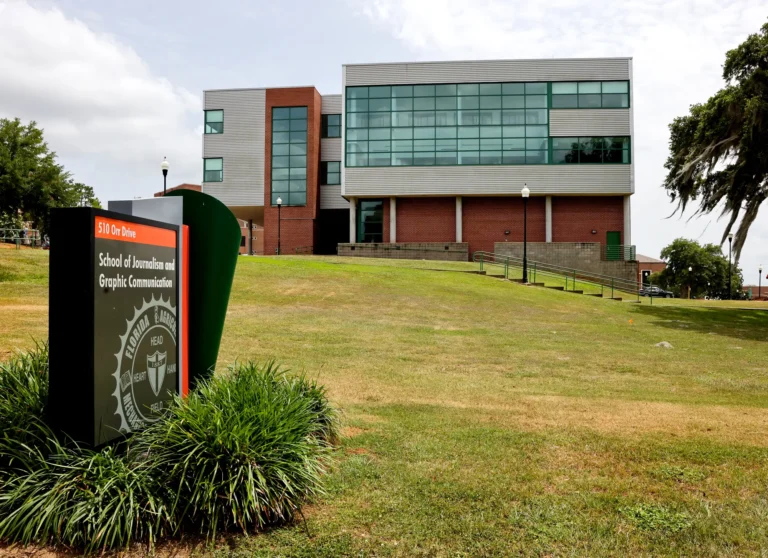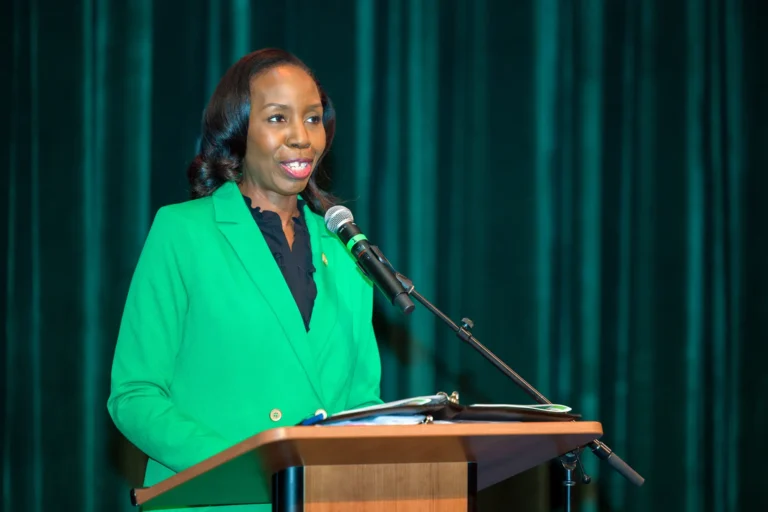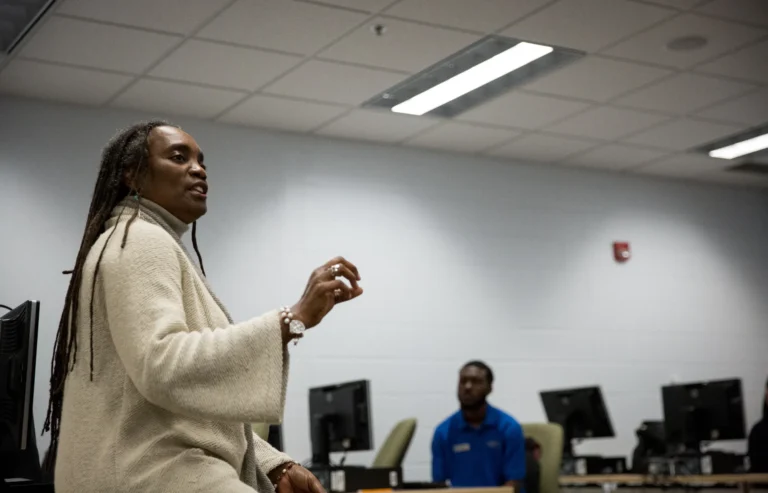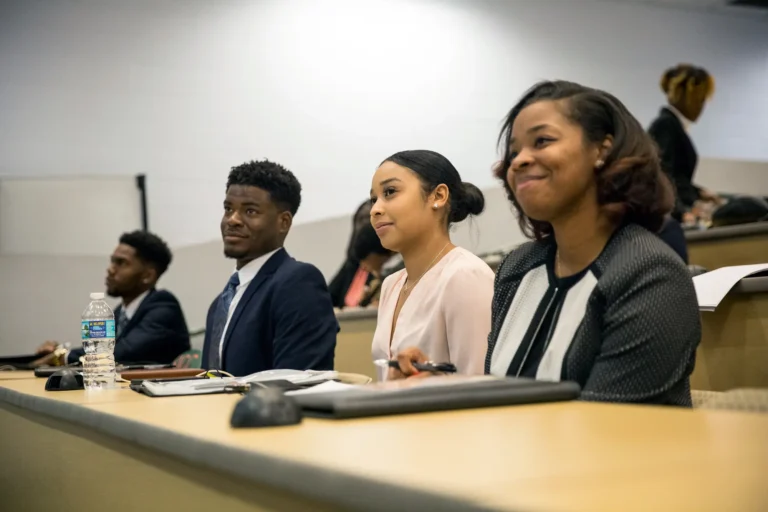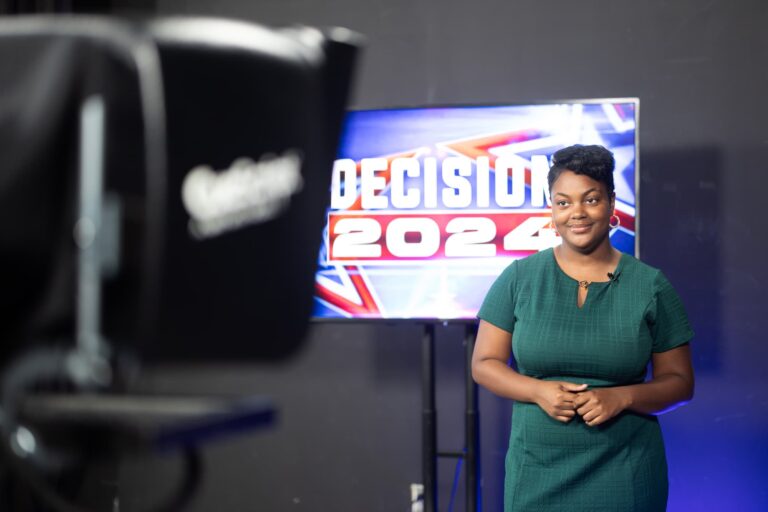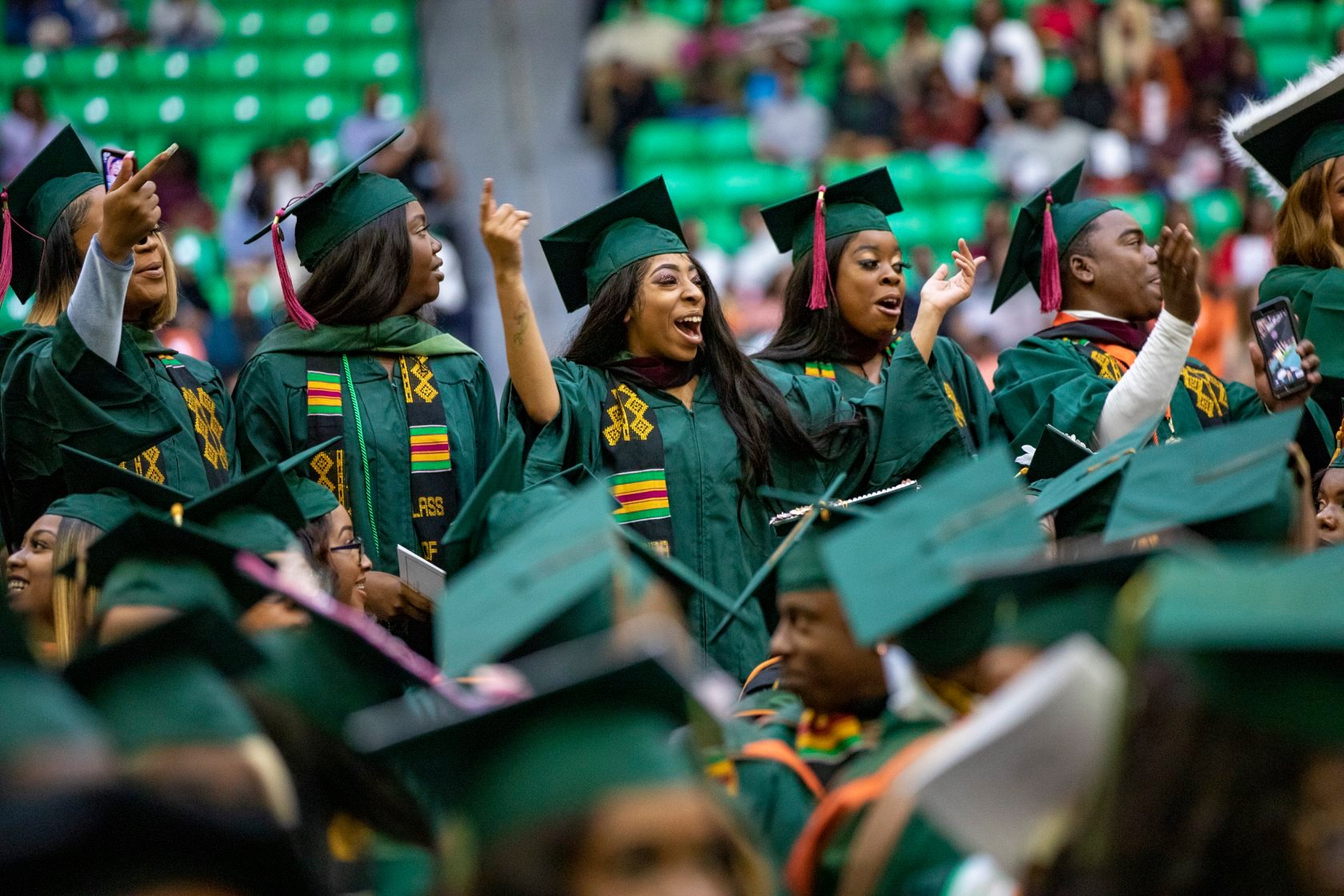
Table 1. Students
Complete Tables 1-3 that were provided in a separate file. You may insert the tables here in the main body of the self-study report or provide links to access the tables in separate windows.
Requirements:
- List each separate program of study in the unit (emphases, concentrations, sequences, or majors)
- Identify each program with separate requirements
- Provide number of students by class year for 2023-2024 academic year
- List students by sequences/tracks if applicable
- Include all subsidiary programs of study
- Show undergraduate degrees conferred during 2023-2024 academic year across all terms
Note: At FAMU, the academic year begins in summer. For example, summer 2022 is the first semester of the 2022-2023 AY, followed by fall 2022 and spring 2023.
Total Degrees Awarded 2023-24 Academic Year
| Major | Number of Degrees |
|---|---|
| Journalism | 40 |
| Public Relations | 28 |
Degrees Awarded by Semester
| Semester | Journalism | Public Relations |
|---|---|---|
| Summer 2023 | 5 | 7 |
| Fall 2023 | 10 | 8 |
| Spring 2024 | 25 | 13 |
Table 1. Students
List below each of the separate programs of study in the unit. These may be called emphases, concentrations, sequences, or majors; please identify each program with a separate set of requirements.
Give the number of students by class (year in school) in each of these programs at the end of the 2023–2024 academic year. If all of your students technically come under one major but you subdivide those majors into sequences or tracks, please list students by those sequences or tracks. Please be sure to list separately all subsidiary programs of study, even if not formally identified by computer or register codes.
Show the number of undergraduate degrees conferred during academic year 2023–2024. Please include all semesters or quarters. If the unit has a formal pre-major status, list the number of such students.
| Undergraduate programs of study | Freshman | Sophomore | Junior | Senior | Total students | Degrees Conferred 2023-24 |
|---|---|---|---|---|---|---|
| Pre-majors, if any* | 51 | 47 | 32 | 2 | 132 | |
| Journalism | 2 | 12 | 43 | 74 | 131 | 40 |
| Public Relations | 3 | 12 | 29 | 38 | 82 | 28 |
| Total students | 56 | 71 | 104 | 114 | 345 | 68 |
* Students who have declared their intention but have not completed the requirements for admission to the major.
Table 2. Full-Time Faculty
List names of full-time journalism and mass communications faculty members assigned to the unit and provide requested information for the quarter or semester immediately preceding the accreditation visit. Add or delete lines as needed.
(As part of the updated General Information Section, faculty lists will be updated to reflect the academic term when the visiting team is on campus. For more information, see the “General Information” section of the Self-Study report form.)
Semester or Quarter: Fall 2024
(Scroll right to view table)
| Name and Rank | Years full-time in industry | Years college teaching | Years on this faculty | Years at present rank | Highest earned degree | Tenured (y/n) | Credit hours taught per semester | % of time tchg, rsch, svc |
|---|---|---|---|---|---|---|---|---|
| Unit Administrator | ||||||||
| William Jiles | 30 | 14 | 14 | 7 | MA | N | 6 | 60/40 administrative & teaching |
| Professors | ||||||||
| Jeffrey Wilkinson | 6 | 32 | 6 | 13 | Ph.D | Y | 9 | 60/30/10 |
| Felicia McGhee | 13 | 24 | 1 | 1 | Ph.D | N | 3 | 16.66/20/63.34 |
| Kenneth Jones | 38 | 29 | 29 | 14 | MFA | N | 9 | 60/40 |
| Mira Lowe | 28 | 2 | 3 | 3 | MA | Y | 0 | 100 Administrative |
| Associate Professors | ||||||||
| Bettye Grable | 8 | 21 | 18 | 12 | Ph.D | Y | 9 | 60/10/30 |
| Hsuang Hsuan | 8 | 21 | 6 | 1 | Ph.D | Y | 9 | 46.66/33.34/20 |
| Leah Hunter | 13 | 10 | 10 | 2 | Ph.D | Y | 9 | 60/20/20 |
| Douglas Blackburn | 35 | 10 | 10 | 10 | MA | N | 9 | 60/40 |
| Instructors/Lecturers | ||||||||
| Clarence Fowler | 6 | 1 | 1 | 1 | MA | N | 9 | 60/40 |
| Arionne Nettles | 7 | 5 | .5 | .5 | MA | N | 9 | 60/40 |
| Maureen Tartaglione | 32 | 1.5 | .5 | 1.5 | MA | N | 6 | 40/60 |
| Venise Toussaint | 12 | 1.5 | 1.5 | 1.5 | MA | N | 6 | 40/60 |
Tables 1-3 Undergraduate 2023-24 Self-Study Year
(As part of the updated General Information Section, faculty lists will be updated to reflect the academic term when the visiting team is on campus. For more information, see the “General Information” section of the Self-Study report form.)
Semester or Quarter: Fall 2024
List names of full-time journalism and mass communications faculty members assigned to the unit and provide requested information for the quarter or semester immediately preceding the accreditation visit. Add or delete lines as needed.
- Douglas Blackburn
- Clarence Fowler
- Bettye Grable
- Hsuan Huang
- Leah Hunter
- William Jiles
- Kenneth Jones
- Felicia McGhee
- Arionne Nettles
- Maureen Tartaglione
- Venise Toussaint
- Jeffrey Wilkinson
Table 3. Part-Time Faculty
List names of part-time faculty paid from journalism and mass communications funds and provide requested information. List should include personnel, including laboratory instructors and teaching assistants, who taught any regular course during the two semesters or quarters before the accreditation visit. Present the names in groups by semester or quarter. Put an X under the appropriate teaching responsibility. Add or delete lines as needed.
Semester or Quarter: Fall 2024
(Scroll right to view table)
| Name and Rank | Years full-time professional experience | Years teaching experience | Highest earned degree | Now working full-time as professional (y/n) | Working toward degree (y/n) | Credit hrs. teaching this semester | In charge of course |
|---|---|---|---|---|---|---|---|
| Zak Dahleimer Adjunct | 10 | 1 | MA | Y | N | 3 | 1 |
| Ranata Hughes Adjunct | 8 | 10 | MS | N | N | 5 | 1 |
| Chandra Lanier Adjunct | 15 | 4 | MA | Y | N | 3 | 1 |
| Patricia MacEnulty Adjunct | 0 | 30 | Ph.D | N | N | 3 | 1 |
| Glyndell Presley Adjunct | 20 | 22 | Ed.D | Y | N | 9 | 1 |
| Fadia Patterson Adjunct | 13 | 4 | MA | Y | N | 6 | 1 |
| Deborah Thigpen Adjunct | 32 | 13 | DBA | Y | N | 3 | 1 |
List names of part-time faculty paid from journalism and mass communications funds and provide requested information. List should include personnel, including laboratory instructors and teaching assistants, who taught any regular course during the two semesters or quarters before the accreditation visit. Present the names in groups by semester or quarter. Put an X under the appropriate teaching responsibility. Add or delete lines as needed.
Spring 2024
- Ranata Hughes
- Chandra Lanier
- Patricia McEnulty
- Glyndell Presley
- Fadia Patterson
Fall 2024
- Zak Dahleimer
- Ranata Hughes
- Chandra Lanier
- Patricia McEnulty
- Glyndell Presley
- Fadia Patterson
- Deborah Thigpen
Spring 2025 (Unconfirmed)
| Name |
| Zak Dahleimer |
| Ranata Hughes |
| Chandra Lanier |
| Patricia McEnulty |
| Glyndell Presley |
| Fadia Patterson |
- Describe the history of the unit in no more than 500 words.
Florida A&M University introduced its first journalism curriculum in 1974, developed by English professors Thelma Gorham, Dana Preu, Annette Thorpe, and Bernice Reeves. The Department of Journalism was established later, led by Robert M. Ruggles. The first class graduated with a Bachelor of Science in journalism in 1978.
In 1982, FAMU became the first historically black university to receive national accreditation in journalism from the Accrediting Council on Education in Journalism and Mass Communications (ACEJMC). ACEJMC President Don Carter praised the high quality of students, faculty, and administrative support.
The School of Journalism, Media and Graphic Arts was founded the same year, with Ruggles as dean and James E. Hawkins as division director. It was renamed the School of Journalism & Graphic Communication (SJGC) in 2002, and in 2005, it moved to a new building featuring TV studios, a radio station, and smart classrooms. WANM 90.5 FM, the campus radio station, began broadcasting in 1976 and operates 24/7 at 1600 watts. Recognized by The Princeton Review, WANM is one of the top college radio stations. FAMU TV-20 launched its first live student broadcast in 2007, serving four North Florida counties and airing various university events.
SJGC also houses The FAMUAN newspaper and Journey Magazine, both significant student publications. Since its inception, SJGC has maintained a standard of excellence in preparing students for careers in journalism, public relations, and graphic design. Students have received accolades from various organizations, including the Associated Press, the National Association of Black Journalists, and the Society of Professional Journalists. They have also secured internships and employment with renowned companies such as Disney, Microsoft, Amazon, JPMorgan Chase, CBS News, CNN, NBC Universal, ABC News, The New York Times, Politico, TEGNA, Gray Television, Wall Street Journal, Glamour, and 3M.
- Describe the environment in which the unit operates, its goals and plans, budgetary considerations, and the nature of the parent university.
Founded October 3, 1887, as the State Normal College for Colored Students, Florida Agricultural and Mechanical University (FAMU), commonly known as Florida A&M University, is a public, historically black university in Tallahassee, Florida. From its modest beginnings with two instructors and 15 students, to its designation in 1909 as Florida Agricultural and Mechanical College for Negroes (FAMC), to its elevation to university status in 1953, FAMU has evolved into a comprehensive 1890 land-grant, doctoral research university that has distinguished itself as a national leader in many areas. Today, FAMU is highly regarded as one of the nation’s top historically black colleges and universities (HBCU) and is part of the 12-member State University System (SUS) of Florida. FAMU enrolls nearly 10,000 students from across the United States and more than 70 countries.
What distinguishes FAMU from other universities is its legacy of providing access to a high-quality, affordable education with programs and services that guide students toward successfully achieving their dreams. As the nation’s highest ranked public HBCU for the sixth consecutive year, and amongst the SUS leaders in providing access for first-generation and low-income students, FAMU remains focused on addressing the critical needs of Florida’s citizens and the nation. FAMU is accredited by the Southern Association of Colleges and Schools Commission on Colleges (SACSCOC).
The University’s Boldly Striking 2022-2027 Strategic Plan highlights five strategic priorities: Student Success, Academic Excellence, Leverage the Brand, Long-Term Fiscal Health and Sustainability, and Organizational Effectiveness and Transformation. The plan’s goals and budgetary considerations are focused on promoting a sense of excellence, innovation, and transformation throughout the institution. FAMU’s strategies aim to enhance the quality of the student educational experience, elevate performance against internal and external metrics, foster faculty excellence, and position FAMU to become a Carnegie classified R1 research institution.
The School of Journalism & Graphic Communication (SJGC) encompasses two divisions: Journalism and Graphic Communication. The Journalism Division provides instruction in digital, broadcast, and print journalism, as well as public relations. Meanwhile, the Graphic Communication Division focuses on contemporary graphic design education.
In Fall 2024, the Division of Journalism had 212 students, while the Division of Graphic Communication had 132 majors. Additionally, 137 students were enrolled as Pre-Journalism majors. The Journalism division is supported by 13 full-time faculty members (including the dean and associate dean), and the Graphic Communication division by four full-time faculty members.
To complete their degrees, students in journalism, public relations, and graphic design are required to take courses across both divisions, ensuring a well-rounded and interdisciplinary education. Journalism and PR students enroll in two courses within the Graphic Design curriculum: Basic Computer Operations and Basic Design Principles. These courses are instructed by faculty in the Graphic Communication Division. Graphic Design students take Language Skills for Media Professionals, Introduction to Mass Media, Multimedia Oral Engagement, and Communication Law & Ethics, which are taught by the Division of Journalism faculty.
The strategic priorities and goals of the academic unit closely align with the University’s strategic plan. In Fall 2021, FAMU named Mira Lowe the dean of SJGC. Since her appointment, the School has focused on building a culture of stability, collegiality, accountability, and inspiration. SJGC’s core values – collaboration, creativity, innovation, and professionalism – are central to the School’s operations and performance.
SJGC’s overarching strategic priorities:
- Strive to make our program a desired choice for students interested in becoming communication professionals and scholars, and to strengthen their readiness and competitive standing in the workforce. Priority One for SJGC is aligned to the University’s Strategic Priority. 1: Student Success. FAMU aims to position itself as an institution of choice for talented students by enhancing the quality of the student educational experience and optimizing academic programs. SJGC seeks to do the same by ensuring that it attracts a pool of high-quality students with writing and oral presentation skills to deliver quality broadcast, digital and public relations content to diverse audiences.
- Heighten our reputation for academic excellence and scholarship by establishing authority in distinct research, raising the profile of our faculty and developing our staff. This corresponds with Strategic Priority 2: Academic Excellence for the University as it focuses on fostering faculty excellence, elevating performance against internal and external metrics, and positioning itself to become a Carnegie classified R1 research institution. SJGC also has a dedication to enhance the footprint of creative scholarship and research productivity for its faculty.
- Extend our reach and impact by promoting the brand, communicating achievements, increasing global recognition and interdisciplinary research. This is in line with Strategic Priority 3: Leverage the Brand. The plan emphasizes promoting FAMU’s achievements, increasing global recognition, and encouraging interdisciplinary research to enhance the University’s reputation. SJGC actively champions the success of its faculty, students, and alumni across various platforms; raises awareness of the program via engagement events; and builds partnerships with academic institutions and organizations.
- Build operational, fundraising and recruitment capacities to support and sustain our strategic priorities and assure longevity of our program. This aligns with Strategic Priority 4: Long-Term Fiscal Health and Sustainability. FAMU aims to implement a planning and budgeting process that secures and allocates funding, ensuring the University’s financial health and sustainability. SJGC aims to strengthen capacity through strategic hiring, collaborations, and cultivation of financial support.
- Foster a flourishing culture of collaboration, creativity, innovation, and professionalism at SJGC. We look to serve our stakeholders with excellence, implement high-quality internal processes and elevate the overall performance of our program. This lines up with FAMU’s Strategic Priority: Organizational Effectiveness and Transformation that concentrates on optimizing the effectiveness of operations through enhancement of processes and innovation.
Budgetary and Allocation Processes at Florida A&M University
The Board of Governors (BOG) allocates State University System (SUS) funds to each university. The President sets distribution guidelines, and the Chief Financial Officer (CFO) with the Budget Office distributes resources to divisions, including Academic Affairs. Deans and Department Heads consult with the Provost and Vice Presidents to allocate resources to schools, colleges, and departments per the President’s guidelines. The CFO reviews these distributions and recommends budgets for the President’s approval, which are then submitted to the Board of Trustees for final approval.
FAMU employs nearly 1,800 staff, including around 700 faculty members. With an annual budget of approximately $12.5 million from the State of Florida, about 75-80% goes to academic units for salaries and personnel.
Budget for the School of Journalism and Graphic Communication (SJGC):
SJGC receives funding for faculty salaries, other personnel services, expenses, and operating capital outlay from the Division of Academic Affairs. The recent budget was $3,518,427, comparable to the School of Architecture and Engineering Technology (SAET) and the School of the Environment. SAET offers four undergraduate and one graduate program, with three accredited. The School of the Environment has two undergraduate and two graduate programs.
SJGC offers three undergraduate programs. The table below shows the budget for all three schools.
| Year | SJGC | Architecture | Environment |
|---|---|---|---|
| 2017-2018 | $2,475,206 | $3,353,044 | $1,856,028 |
| 2018-2019 | $2,682,331 | $3,527,361 | $1,869,081 |
| 2019-2020 | $3,006,936 | $3,749,328 | $2,025,588 |
| 2020-2021 | $3,167,289 | $3,951,312 | $2,338,428 |
| 2021-2022 | $2,876,708 | $3,702,453 | $1,785,778 |
| 2022-2023 | $2,944,461 | $3,737,667 | $1,817,539 |
| 2023-2024 | $3,616,434 | $3,908,531 | $1,972,764 |
| 2024-2025 | $3,518,427 | $3,639,435 | $2,447,848 |
In the budgeting process, SJGC considers Performance Based Funding (PBF) metrics focusing on:
- Expanding professional development (Metrics 1: Graduates Employed/Continuing Education; 2: Median Wages of Full-time Employed Graduates).
- Enhancing academic and student support services (Metrics 4: Four-Year Graduation Rate; 5: 2nd Year Retention with GPA Above 2.0).
SJGC funds also hire and retain faculty/staff, update curriculum/instructional needs, upgrade equipment/software, manage facilities, and offer digital services. Additional financial support comes from fundraising, PBF dollars for student success initiatives, and Title III funding for technology.
- Describe any recent major changes in the mission, goals, or programs and activities of the unit.
SJGC’s mission statement adopted in 2017 was modified in 2023 to reflect the School’s pedagogical emphasis on active learning and experiential experiences that provide real-world, skills-building opportunities to students. These experiences prepare SJGC scholars to be confident, multi-platform communicators in an ever-evolving media marketplace.
To ensure that the programs in journalism and public relations continue to meet industry and students’ needs, updates have been made in: (1) Curriculum, (2) Student Services, (3) Academic Excellence, (4) and Student Success. No changes have occurred to the overall goals of the unit.
Curriculum Changes (2020-2022)
Faculty recognized the need to update the curriculum to enhance student learning outcomes, eliminate redundancies, and better prepare students for the competitive journalism and media industry. The new and revised courses include:
- Multimedia Oral Engagement: This new class aims to increase students’ oral communication media skills and engagement competency for today’s professional media marketplace and employment.
- Social Media & Data Analytics: This new class seeks to enhance the public relations, internship, and employability skills for students in a fast-growing area in media.
- Entrepreneurship, Leadership & Innovation: This new class prepares students to pursue media entrepreneurship, leadership, and innovation by learning about leadership principles, launching their own business, building digital media products, or developing content strategy.
- International Issues & The Media: The aim of this new course is to increase students’ critical thinking and global awareness of international issues and the media while increasing their ability to be thought leaders.
- Use of Information Resources: The credit hours for this course were changed from two to three credits to increase the instruction needed to help students learn digital and information tools used daily by journalism and public relations practitioners.
- Visual Storytelling: The purpose of this new class is to give students in-depth understanding and skills required to tell compelling stories which emphasize visual modalities.
- Capital Bureau: Formerly Public Affairs Reporting, this class focuses on local and statehouse reporting in multimedia formats.
- Public Relations Agency: In this class, students learn how to create comprehensive campaigns for clients using research-based strategies to meet the clients’ goals and objectives.
Writing Lab Establishment (2022-2023)
Establishing a writing lab (The Writer’s Block) is crucial to help students develop strong writing skills, which are essential for success in journalism and public relations. As part of its plan to increase student success and performance in the classroom, the academic unit received University funding to support the development of a writing lab. With the funding, the Division of Journalism then worked with the campus facilities team to convert unused space into a functional lab for in-person tutoring, seminars, and writing/editing stations. The lab became operational in Spring 2023, with faculty providing coaching on course assignments, resumes, cover letters, and Capstone portfolios.
Credit Hour Adjustment (Fall 2024)
The FAMU Board of Trustees approved reducing the required credit hours for the Bachelor of Science degrees in journalism and public relations from 125 to 120, aligning with other Florida SUS institutions and in an effort to increase graduation and retention rates.
Student Services
In Spring 2023, the University introduced a new advisement model, drawing on best practices from the NACADA (National Academic Advising Association) and our State University System peers. This initiative significantly enhanced the support structure for our journalism and public relations students. At the unit level, SJGC was bolstered by two new advisers, complementing the existing Academic Programs Coordinator. With this new team in place, the unit implemented academic success workshops, academic advising program guides, graduation checklists, and SJGC Connect, a new booking system for advisement appointments.
The Academic Success Workshops provide students with essential skills and strategies to excel in their studies. The academic advising program guides and graduation checklists provide advisors with consistent mechanisms to ensure students understand the resources and support available to them as well as adequately track their progress towards graduation, ensuring they meet all necessary requirements. SJGC Connect has been helpful in streamlining the process of scheduling advisement appointments, making it easier for students to access the support they need. These enhancements have collectively contributed to the improved academic performance and success of our journalism and public relations graduates, ensuring they are well-prepared for their professional careers.
Academic Excellence
The unit celebrated the promotion and tenure of three journalism and public relations faculty in 2022-2023 and 2023-2024. One journalism associate professor (Dr. Jeffrey Wilkinson) received tenure and was promoted to full professor; one journalism assistant professor (Dr. Leah Hunter) received tenure and was promoted to associate professor; and another public relations assistant professor (Dr. Hsuan Huang) received tenure and was promoted to associate professor. The journalism division faculty have also been recognized locally and nationally for their scholarship and creative works. A professor (Kenneth Jones) released his third independent movie My Music, which shines a light on caregiving challenges and Alzheimer’s. It first debuted to wide audiences at the 2019 Sedona Film Festival and was shown locally at the CMX Cinemas in 2021. An associate professor (Dr. Valerie White) was selected for the inaugural cohort of the Solutions Journalism HBCU/Black Press Academy + Lede Fellowship in 2023. This cohort of educators from HBCUs and newsroom leaders from the Black Press spent a year learning how to incorporate solutions journalism into their curricula and media operations. In 2024, an associate dean (Dr. Felicia McGhee), who is a board member of ASJMC (Association of Schools of Journalism and Mass Communication), was elected to the ACEJMC Accrediting Council.
As shown above, SJGC faculty are actively involved in various regional, national, and international professional activities, providing academic service to the field. Other examples of faculty excellence include displays of leadership within external organizations. For example, a faculty member (Jeffrey Wilkinson) holds a leadership position in the International Division of the Broadcast Education Association and is also on the editorial board for the Journal of Radio and Audio Media (JRAM).
SJGC faculty are also engaged in community and collaborative partnerships with other disciplines. A SJGC professor (Jeffrey Wilkinson) is the primary faculty facilitator for a community entrepreneurship program funded by the National Institutes of Health (NIH) Path to Excellence and Innovation (PEI), offered through the FAMU Innovation Center. After one and half years, the program has successfully launched approximately two dozen individuals into the local community entrepreneurial ecosystem.
In 2023-2024, another professor (Kenneth Jones) collaborated with the College of Social Sciences, Arts and Humanities, on The FAMU Stories of Inspiration (SOI), a grant video project to produce inspirational biographical stories that, along with instructional materials, will be used by the Florida Department of Education for instruction in Florida K-12 schools.
Student Success
Thanks to a $1 million, multi-year grant from The Walt Disney Company, the academic unit established the Disney Storytellers Fund at FAMU in 2022. The grant is part of the Disney Future Storytellers program, an initiative aimed at increasing access to careers in storytelling and innovation for individuals from historically underrepresented or marginalized communities. The donation to SJGC provides selected students with tuition and housing scholarships, a stipend, specialized programming, mentoring, leadership development, and internship opportunities. Since receiving the grant, 28 students have interned in various departments at ABC News in New York City and other Disney properties during the summer, sharpening their writing, research, and production skills.
Link for Disney Storytellers Fund
The academic unit also became a new academic partner with NBCU Academy, the NBCU News Group’s multi-platform journalism training and development program and received a $175,000 grant for direct student and course support. The funding enhanced the unit’s capacity to help students with tuition, housing, books/materials as well as cover technology needs for courses such as the Capital Bureau, which focuses on statehouse reporting and local news.
Link for NBCU Academy Grant
In 2022, the dean launched the SJGC Assistance Program to help students with financial hardship stay in school. SJGC has awarded $258,764 to date.
Link for SJGC Assistance Program
During the reporting period, SJGC students received regional and national recognition for their work. Among their awards: a regional and national Edward R. Murrow Award from the Radio Television Digital News Association (RTDNA) for a collaboration with the University of Florida. The winning project, UFxFAMU1963: Reporting from the U.S. Civil Rights Trail, won for Excellence in Diversity, Equity and Inclusion.
Other examples of student excellence included honors from the Florida Association of Broadcast Journalists and the Intercollegiate Broadcasting System (IBS). For the 2024-2025 academic year, the unit’s student-run radio station, WANM-FM, was named a finalist in the Best College/University Station (Under 10,000 Students) category and Best Spot News category in the IBS 2024-25 College Media Awards competition. Winners will be announced in March 2025 in New York City.
Link for Edward R. Murrow Award
SJGC students won first place and a $40,000 grant in the 2024 Coca-Cola HBCU Sports Production Grant Competition for their documentary about the late Pro Football Hall of Famer and FAMU graduate Ken Riley and his impact on the sport. Students also won this production competition in 2023.
Link for Coca-Cola HBCU Sports Production Grant
During the 2023-2024 academic year, student leaders of The FAMUAN were successful in receiving a $12,000 award from Howard University’s Center for Journalism and Democracy through its inaugural Newsroom Innovation Challenge. The funding will support the development of a news app and members of the newsroom staff.
Link for Howard University Newsroom Innovation Challenge Grant
Link for other SJGC Student Awards from 2019-2024
- If the unit was previously accredited, summarize each deficiency noted in the most recent accreditation report that the site team said should be addressed (Part 3 of site team report), followed by a response to each, explaining actions taken to address the problems and the results. If the unit was in noncompliance in the same standard(s) on the previous two visits, identify the standard(s), the reasons cited, and how these problems have been addressed.
The 2018 site team evaluating the unit found seven of nine standards in compliance and noted faculty, facilities, and alumni engagement as hallmarks of the program. However, two standards were deemed out of compliance, Standard 5. Scholarship and Standard 9. Assessment, citing underperforming faculty scholarship and incomplete and inconsistent execution of assessment. The site team also identified two other concerns: student-teacher ratio in skills courses and unsettled leadership at the campus and unit levels.
The unit was put on provisional status and agreed to seek re-accreditation again in two years.
Link for 2019-2020 Revisit
Actions Taken
Standard 5. Scholarship: Research, Creative and Professional Activities
The unit reinforced its Tenure and Promotion guidelines for tenure-track professors, and recruited and hired two research-driven tenure-track faculty, one at the assistant professor rank and one at the associate professor rank, both with Ph.Ds. Other actions included establishing a 3/3 teaching load to support research productivity; providing funding for faculty development and research; and promoting the research efforts of faculty to internal and external stakeholders. These deliberate steps helped to foster faculty research and creative productivity.
Standard 9. Assessment of Learning Outcomes
Working closely with the Office of University Assessment and the Office of Academic Program Quality, the unit developed consistent and useful assessment processes to evaluate student learning outcomes that utilized both direct and indirect measures. Direct measures included pre-post-tests, rubric-based criteria, targeted assignments, exams, and capstone projects. Indirect measures included student surveys and evaluations. A renewed commitment to assessment resulted in more intentional discussions at division and all-school meetings; training sessions and routine course reviews; and coordinated efforts led by the SJGC Assessment Committee Chair (Dr. Leah Hunter).
During their 2020 revisit, the site team noted in its report that the unit had made steady progress in addressing Standards 5 and 9, in addition to controlling enrollment in professional classes by adding new faculty and managing offerings more effectively. All skills classes in journalism and public relations were in compliance by Spring 2020. The site team reported that the unit’s interim leadership appeared more anchored compared to the full visit in 2018. The site team recommended reaccreditation. Upon review of the actions taken, both the accrediting committee and accrediting council voted for full accreditation.
From 2018-2024, the unit has seen continual progress in the number of peer-reviewed publications or comparable scholarship activity, number of external conference presentations and in the percent of full-time faculty with at least one creative project or activity.
- Describe the process used to conduct the self-study, including the roles of faculty members, students, and others. Describe the strengths and weaknesses of the program discovered during the self-study process, and describe any changes undertaken or planned as a result.
The Process
Faculty teams of two were created and assigned at least one standard. Staff were also engaged in the collection of data respective to their areas. This method has been used in several previous self-studies. There were checkpoints during the semester to determine the progress of each team. The strength of this model is that everyone is involved in the process.
- A shared drive was created for faculty to upload data for the standards and to view documents.
- Accreditation and self-study updates were given at all-school meetings, division meetings, leadership meetings, at the faculty and staff fall retreat and via email.
- Faculty and administrators attended ACEJMC’s virtual accreditation workshops.
- A self-study retreat was dedicated solely to the reviewing and revising of standards.
- The University’s Office of Program Quality and Division of Strategic Planning, Analysis, and Institutional Effectiveness provided guidance and support during the process.
The self-study provided the unit the greatest opportunity to reflect and assess the School’s progression since its last self-study in 2017. During the review, the unit identified growth opportunities and areas for improvement.
The unit experienced an increase in faculty research and creative works with the hiring of scholars and more investment in their scholarship to travel, make presentations, obtain technology etc. Since 2018, the unit has seen notable growth in the annual number of peer-reviewed publications and the number of external conference presentations. Building a culture of research at the unit also included encouraging scholarship at the undergraduate level in classes by focusing on research methodologies and projects.
In its evaluation, the unit noted an expansion of its employer network, generating more internships and jobs for students. From 2018-2023, the SJGC Office of Career Success (OCS) hosted several professional development and career events throughout each year for SJGC majors. The number of engagement opportunities increased significantly, from three events in 2018 to 28 in 2022 and 25 in 2023. A signature event for SJGC is its annual Fall Student Career Fair held during Homecoming Week in October. The fair draws 20-30 recruiters from across the state and country to meet and interview prospective interns and employees.
Keeping pace with innovation and industry standards is a high priority of the unit. During the self-study year, SJGC was able to better chronicle its technology, facility upgrades and forecast its future needs. The unit has obtained more than $1 million in new technology for classrooms, studios, and student media since the site team revisited in 2020. A major investment of $775,000 from the Title III Office in 2023 supported the upgrade of equipment in the unit’s TV and radio stations; the addition of several TV hand-held cameras for reporting in the field; and the capacity to broadcast live while on location.
The self-study also allowed the unit to pinpoint stress points and re-evaluate processes and practices. Areas for improvement include:
- Increasing enrollment, especially due to the steady decline over the past six years. In Fall 2019, enrollment was 406 students, down from a peak of 499 in Fall 2015. Most recently, the number has dropped to 349 across journalism, public relations, and pre-majors. Consequently, the School is hiring a full-time recruiter to address this challenge.
- Revamping a legacy committee structure. For its size and capacity, the unit has too many SJGC committees resulting in heavy service loads and inconsistent productivity. The unit streamlined the committee structure in 2024 to uphold faculty governance.
- Needing more online courses/sections and institutional support to expand the availability of courses for the academic progression of students. Expanding the online curriculum would also bolster student retention and recruitment of instructors. To jumpstart this effort, the unit is offering stipends to faculty for online course development for 2025.
- More funding for hiring full-time research faculty, instructors, and support staff to meet growing instructional needs, student progression and aspirations of the program. Salary compression and compensation challenges affect the unit’s ability to attract and retain high-quality faculty and staff. SJGC is actively collaborating with the University administration to address these concerns.
- Succession planning for faculty. Starting in Spring 2024, the unit began seeing the retirement of its most senior and tenured faculty members, a trend expected to continue over the next 2-3 years. To ensure continuity in instruction and research, and to preserve the invaluable institutional knowledge of these long-serving scholars, a comprehensive succession plan is required.
- Creation of an accreditation taskforce. This committee will be charged to identify issues associated with the accreditation process, engage discussion with faculty, staff, and administrators, and propose strategies to strengthen re-accreditation. It will assist in the planning for future self-studies and site visits.
- Provide the web links to undergraduate catalogs and other publications that describe the mission and scope of the unit, its curriculum, administrative and graduation requirements.
- About the SJGC
- Mission, Vision, Values
- SJGC Strategic Plan (2022-2027)
- About Journalism, Broadcast Journalism, B.S. Major
- About Public Relations, B.S. Major
- SJGC Curriculum Guide – Public Relations (Fall 2024)
- SJGC Curriculum Guide – Journalism (Fall 2024)
- SJGC Graduation Checklist
- SJGC Resources
- SJGC Faculty Directory
- SJGC Staff Directory
